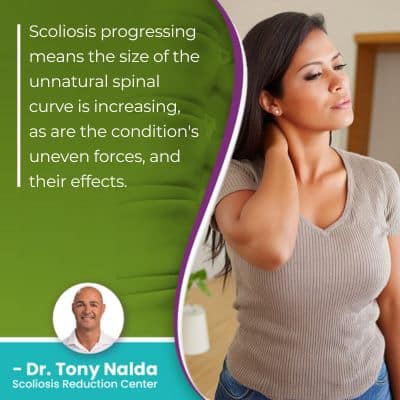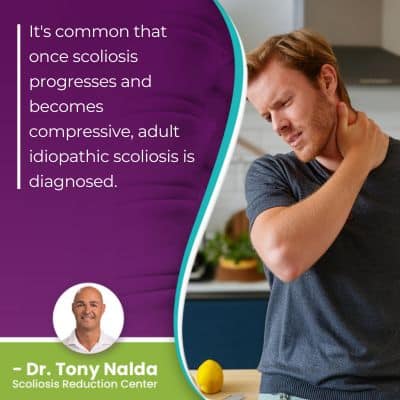Adult Scoliosis Symptoms: Diagnosis, And Effective Treatment

Adult scoliosis is diagnosed once skeletal maturity has been reached, and the condition affects children and adults differently, largely due to compression. Scoliosis doesn't become a compressive condition until the spine is no longer growing.
While scoliosis is more commonly diagnosed in children, it also affects adults; the rate of scoliosis actually increases among the aging population. The main symptom of scoliosis in adults is pain, and treatment involves pain management and increasing the spine's stability.
There are different types of scoliosis, and the two most common types to affect adults are idiopathic scoliosis and degenerative scoliosis.
Table of Contents
Diagnosing Scoliosis in Adults
In order to reach a diagnosis of scoliosis, certain parameters have to be met.
Scoliosis involves the development of an unnatural spinal curve that bends to the side and rotates, and this is a structural spinal condition that's also progressive; the condition's nature is to get worse over time.
A physical examination and X-ray results will confirm what's happening in and around the spine, the curve's rotational component, and the patient's Cobb angle measurement; a minimum Cobb angle of 10 degrees is needed to diagnose scoliosis.
 Scoliosis progressing means the size of the unnatural spinal curve is increasing, as are the condition's uneven forces, and their effects.
Scoliosis progressing means the size of the unnatural spinal curve is increasing, as are the condition's uneven forces, and their effects.
Although incurable, scoliosis can be highly treatable, so let's talk about the two main condition types to affect adults.
Idiopathic Scoliosis
There are different types of scoliosis, and this is determined by causation.
The main type to affect all ages is idiopathic scoliosis, and idiopathic scoliosis has no known cause, and this type accounts for approximately 80 percent of known causes, and the remaining 20 percent of cases have known causes: neuromuscular scoliosis, congenital scoliosis, and degenerative scoliosis.
Types with known causes are considered atypical and can have left-bending curves, when typical cases of idiopathic scoliosis involve right-bending curves.
Neuromuscular scoliosis develops as a complication of a larger neuromuscular condition such as spina bifida, muscular dystrophy, and cerebral palsy, while congenital scoliosis is caused by a spinal malformation that develops in utero so babies are born with the condition.
Adolescent Idiopathic Scoliosis
Adolescent idiopathic scoliosis, diagnosed between the ages of 10 and 18, is the most prevalent condition type overall, and it also causes idiopathic scoliosis in adults.
Cases of idiopathic scoliosis in adults are cases of adolescents who were undiagnosed and untreated during adolescence, and their scoliosis progresses with time and maturity.
One of the main differences between childhood and adult scoliosis symptoms is pain; scoliosis isn't compressive in children so isn't commonly painful, but back pain and pain that radiates into the extremities due to nerve compression is the main symptom of adult scoliosis.
In young patients who are still growing, the spine is experiencing a constant lengthening motion, and this counteracts the compressive force of the unnatural spinal curve.
It's compression of the spine and its surrounding muscles and nerves that causes the majority of condition-related pain.
It's common that once scoliosis progresses and becomes compressive, adult idiopathic scoliosis is diagnosed.
Degenerative Scoliosis
After idiopathic scoliosis, the next most common type of scoliosis to affect adults is degenerative scoliosis, and this is most common in adults over the age of 50 who are facing spinal degeneration.
There is a certain amount of spinal degeneration to be expected with age, and the cumulative effect of certain lifestyle factors also contribute to a patient's level and rate of natural age-related spinal degeneration.
Degenerative scoliosis is also more common in females than males, and this is due to changes in bone density and hormones related to menopause.
Degenerative scoliosis is also known as de novo scoliosis, meaning there is no former history with the condition and that it has developed fresh in adulthood, unlike idiopathic scoliosis.
Degenerative scoliosis will make the spine increasingly unbalanced and unstable and most often starts with degenerative disc disease; the spinal discs are commonly the first spinal structures to start to deteriorate, and when this happens, the deteriorating disc(s) tend to become desiccated and change shape as a result; this affects the position of adjacent vertebrae attached and disrupts the spine's ability to maintain its natural curves and alignment.
Adult Scoliosis Treatment Options
 The spine has three main sections: the cervical spine (neck), thoracic spine (middle/upper back), and the lumbar spine (lower back).
The spine has three main sections: the cervical spine (neck), thoracic spine (middle/upper back), and the lumbar spine (lower back).
Scoliosis can develop in any of the spine's main sections or in more than one as a combined scoliosis, and when it comes to treating adult scoliosis, the focus is on increasing the spine's stability to preserve its strength, function, and overall health.
While spinal surgery is sometimes recommended, when it comes to scoliosis, many cases don't require spinal fusion, and the proven results of a conservative nonsurgical treatment approach speak to that.
Nonsurgical treatment is proactive so is started as close to the time of diagnosis as possible, and this is done in the best interest of persevering spinal health and preventing progression; this involves chiropractic care and adjustments to help address the structural nature of scoliosis.
Chiropractic Care
The goal of treating scoliosis in children is to achieve a significant curvature reduction to counteract the progressive trigger in growth, but this is removed in adults, so while a goal of treatment is to achieve a curvature reduction, it's more so to reduce a curvature back to where it was prior to becoming painful.
Chiropractic adjustments and a variety of techniques can be applied in order to reposition the curve's most-tilted vertebrae back into alignment with the rest of the spine.
The goal of chiropractic care is to restore as much of the spine's healthy curves as possible to achieve corrective results.
Physical Therapy
Physical therapy and scoliosis-specific exercises are applied in an effort to increase core strength; it's not just the spine that's in charge of maintaining its natural curves and neutral alignment, but also the spine's surrounding muscles that provide it with support and stabilization.
Scoliosis-specific exercises can also help improve posture and activate certain areas of the brain for improved brain-body communication.
When the structural changes achieved by chiropractic care are supported by strong surrounding muscles, the spine's stability is improved, and this is a key focus of adult scoliosis treatment.
In addition, keeping the spine and its surrounding muscles strong and flexible can also provide pain relief.
Bracing
Scoliosis bracing is more commonly used as a facet of treatment for childhood scoliosis, but it can be helpful for adults in terms of pain relief and increasing spinal support.
Bracing can also help augment corrective treatment results by pushing the spine into a corrective position, complementing other treatment disciplines.
Rehabilitation
Rehabilitation can involve continued chiropractic care and the prescription of a series of custom-prescribed scoliosis-specific exercises patients can perform from home, and this can help hold results and further stabilize the spine over time.
As a progressive spinal condition, the best time to start scoliosis treatment is always now, and when it comes to treating scoliosis in adults, a spine curvature that's unhealthy can mean an unstable spine that's weaker and more vulnerable to injury.
Many patients with adult scoliosis are experiencing disc degeneration, and curve correction can involve reducing the curve back to where the spine was prior to becoming painful, and increasing core strength can mean keeping the spine surrounded by strong and supportive muscles.
Conclusion
When it comes to effective treatment for adult scoliosis, patients have two main types of treatment to choose between: surgical or nonsurgical treatment.
Surgery involves spinal fusion that has the goal of stopping scoliosis from getting worse, but the risks of surgical treatment increase with age, and if the procedure fails for any reason, the only recourse is more surgery, and the risks increase with age and each subsequent procedure.
A physical exam, taking the patient's family history, medical history, and a scoliosis X-ray is how scoliosis is diagnosed in all patients, and when it comes to adult scoliosis, the most common sign is back pain and pain that radiates into the arms/hands and legs/feet.
Adults will also experience postural changes, such as a prominent lean to one side that's most visible when patients bend forward.
Adult scoliosis treatment is about condition improvement for a better quality of life, and here at the Scoliosis Reduction Center, my adult patients benefit from a conservative chiropractic-centered treatment approach.
Through an integrative treatment approach that combines condition-specific chiropractic care, physical therapy, bracing, and rehabilitation, adult patients can work towards a curvature reduction on a structural level, and increasing core strength and spinal stability through physical therapy and the prescription of scoliosis-specific exercises.
When it comes to minimizing condition effects like pain, the best approach is proactive treatment that addresses the underlying cause of the pain: the scoliosis itself.
Dr. Tony Nalda
DOCTOR OF CHIROPRACTIC
After receiving an undergraduate degree in psychology and his Doctorate of Chiropractic from Life University, Dr. Nalda settled in Celebration, Florida and proceeded to build one of Central Florida’s most successful chiropractic clinics.
His experience with patients suffering from scoliosis, and the confusion and frustration they faced, led him to seek a specialty in scoliosis care. In 2006 he completed his Intensive Care Certification from CLEAR Institute, a leading scoliosis educational and certification center.
About Dr. Tony Nalda
 Ready to explore scoliosis treatment? Contact Us Now
Ready to explore scoliosis treatment? Contact Us Now





